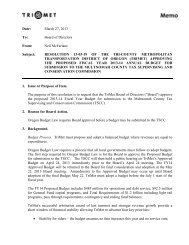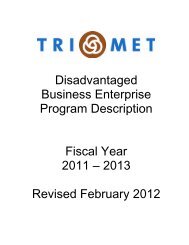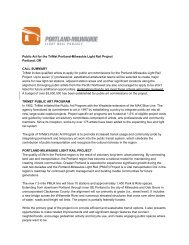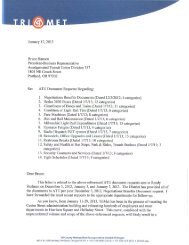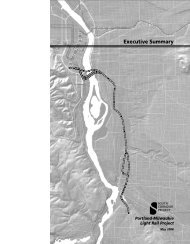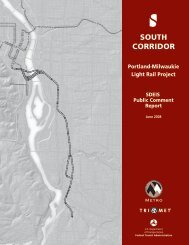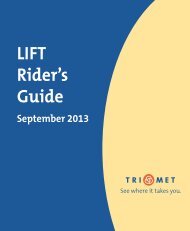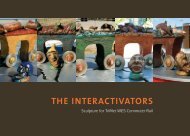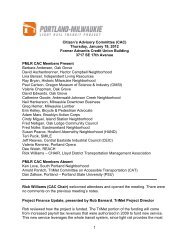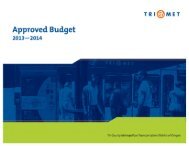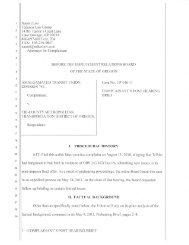TriMet MAX Green Line Public Art Guide (PDF)
TriMet MAX Green Line Public Art Guide (PDF)
TriMet MAX Green Line Public Art Guide (PDF)
You also want an ePaper? Increase the reach of your titles
YUMPU automatically turns print PDFs into web optimized ePapers that Google loves.
<strong>TriMet</strong> <strong>MAX</strong> GREEN LINE<br />
PUBLIC ART GUIDE
Broadway<br />
5<br />
<strong>TriMet</strong> <strong>MAX</strong> <strong>Green</strong> <strong>Line</strong><br />
<strong>Public</strong> <strong>Art</strong><br />
Portland Transit Mall<br />
#<br />
#<br />
#<br />
Podcast available at trimet.org<br />
<strong>MAX</strong> station<br />
New work<br />
Muliple-part work<br />
Original collection<br />
On loan<br />
Mel Katz<br />
Daddy Long Legs, 2006<br />
21<br />
Malia Jensen<br />
Pile, 2009<br />
James Lee Hansen<br />
Winter Rider No. 2, 2003<br />
17<br />
Patti Warashina<br />
City Reflections, 2009<br />
Tom Hardy<br />
Running Horses, 1986<br />
16<br />
Don Merkt<br />
Driver’s Seat, 1994<br />
Lee Kelly<br />
Untitled Fountain, 1977<br />
John Buck<br />
Lodge Grass, 2000<br />
23<br />
Norman Taylor<br />
Kvinneakt, 1975<br />
Melvin Schuler<br />
Thor, 1977<br />
18<br />
Bruce Conkle<br />
Burls Will Be Burls, 2009<br />
19<br />
25<br />
James Lee Hansen<br />
Talos No. 2, 1977<br />
Bruce West<br />
Untitled, 1977<br />
20<br />
Mill<br />
J<br />
27<br />
22<br />
Clay<br />
Market<br />
26<br />
24<br />
M<br />
Columbia<br />
Main<br />
Madison<br />
Jefferson<br />
28<br />
Taylor<br />
Salmon<br />
6th 5th<br />
Yamhill<br />
Alder<br />
Morrison<br />
12<br />
Stark<br />
Oak<br />
Washington<br />
11<br />
Pine<br />
Glisan<br />
4th<br />
Everett<br />
Davis<br />
Couch<br />
Burnside<br />
Ash<br />
Christine Bourdette<br />
Cairns, 2008<br />
Daniel Duford<br />
The <strong>Green</strong> Man of Portland,<br />
2009<br />
3 John Killmaster<br />
Untitled, 1977<br />
4 Ivan Morrison<br />
Untitled, 1977<br />
5<br />
Mark R. Smith<br />
Reading the Street, 2008<br />
6<br />
Mark Calderon<br />
Floribunda, 1998<br />
7 Don Wilson<br />
Interlocking Forms, 1977<br />
10<br />
9<br />
Cris Bruch<br />
Whistlestop for an<br />
Organ Teacher, 2009<br />
Kathleen McCullough<br />
Cat in Repose, 1977<br />
Georgia Gerber<br />
Animals in Pools, 1986<br />
Rick Bartow<br />
The Responsibility<br />
of Raising a Child, 2004<br />
Chris Gander<br />
Puzzle Tower I, 2007<br />
1<br />
2<br />
8<br />
I-205 <strong>MAX</strong> Stations<br />
Anne Storrs<br />
Tall and Fallen, 2009<br />
Carolyn Law<br />
Sky to Earth, 2009<br />
Valerie Otani<br />
Money Tree, 2009<br />
Suzanne Lee<br />
Shared Vision, 2009<br />
Brian Borrello<br />
Lents Hybrids, 2009<br />
Brian Borrello<br />
Johnson Creek Watershed, 2009<br />
Pete Beeman<br />
Waving Post, 2009<br />
7<br />
5<br />
6<br />
2<br />
3<br />
4<br />
1<br />
SE Fuller Rd<br />
Gateway<br />
SE Main St<br />
SE Division St<br />
SE Powell Blvd<br />
SE Holgate Blvd<br />
Lents Town Center/<br />
SE Foster Rd<br />
SE Flavel St<br />
15<br />
Michihiro Kosuge<br />
Continuation, 2009<br />
6th<br />
5th<br />
Montgomery<br />
Harrison<br />
Hall<br />
College<br />
14<br />
13 Robert Maki<br />
TRIMET, 1977<br />
Fernanda D’Agostino<br />
Urban Hydrology, 2009<br />
Richard C. Elliott<br />
Chain of Life, 2008<br />
8<br />
Clackamas Town Center<br />
Transit Center
<strong>TriMet</strong> <strong>MAX</strong> GREEN LINE PUBLIC ART GUIDE<br />
Mary Priester and Michelle Traver<br />
with statements by artists
Published by:<br />
Tri-County Metropolitan Transportation District of Oregon<br />
(<strong>TriMet</strong>)<br />
4012 SE 17th Avenue<br />
Portland, Oregon 97202<br />
503-238-RIDE (7433)<br />
trimet.org<br />
Copyright 2010 by Tri-County Metropolitan Transportation<br />
District of Oregon<br />
This book, or parts of it, may be copied, shared or transmitted<br />
for non-commercial purposes, as long as authorship is attributed<br />
to the Tri-County Metropolitan Transportation District of Oregon.<br />
Any commercial use of any part of this book, without the written<br />
permission of the Tri-County Metropolitan Transportation<br />
District of Oregon, is strictly prohibited. All other rights reserved.<br />
Priester, Mary<br />
Traver, Michelle<br />
<strong>TriMet</strong> <strong>MAX</strong> <strong>Green</strong> <strong>Line</strong> <strong>Public</strong> <strong>Art</strong> <strong>Guide</strong><br />
Editing: Judy Blankenship<br />
Design: Reynolds Wulf Inc., Robert Reynolds, Letha Wulf<br />
Photography: Tim Jewett, Robert Reynolds<br />
Printed by Printing Today, Portland, Oregon
CONTENTS<br />
Preface 7<br />
Introduction 8<br />
Portland Transit Mall 11<br />
I-205 <strong>MAX</strong> Stations 39<br />
Timeline 56<br />
Acknowledgments 57<br />
Contributors 58
PREFACE<br />
In addition to being an exercise in planning,<br />
budgeting and construction, taking a new <strong>MAX</strong><br />
line from concept to finished light rail alignment<br />
is also a creative process. This was certainly the<br />
case with the <strong>MAX</strong> <strong>Green</strong> <strong>Line</strong>.<br />
In the late 1970s, when Interstate 205 (I-205)<br />
was under construction in East Portland and<br />
Clackamas County, a transitway was built alongside<br />
of the freeway. This public right of way<br />
provided the impetus for a regional priority:<br />
a light rail line to connect Clackamas County<br />
with the rest of <strong>TriMet</strong>’s transit system.<br />
After the opening of the <strong>MAX</strong> Yellow <strong>Line</strong><br />
in 2004, various agencies and jurisdictions in<br />
the region focused on realizing this goal. Simultaneously,<br />
revitalizing the main north-south<br />
bus route along 5th and 6th avenues in downtown<br />
Portland, known as the Portland Mall,<br />
became essential to the health of the city and<br />
to expansion of the transit system. One idea<br />
for revitalizing the Mall included new light rail<br />
service to and from Portland State University,<br />
the top destination for transit users.<br />
Regional growth and transit planners created<br />
the innovative plan to combine the I-205 and<br />
Portland Mall alignments into one light rail<br />
line via the existing trackway that runs next<br />
to I-84. This new line would provide riders with<br />
a multitude of destinations and multi-modal<br />
connections.<br />
With this vision, regional partners created<br />
a project that leveraged existing infrastructure<br />
to bring new transit options to communities<br />
not served by light rail in the past. The project<br />
also proposed inventive solutions to the multimodal<br />
use of downtown streets and worked<br />
to bring sustainable practices to construction<br />
and landscaping efforts.<br />
Six years of planning, community outreach<br />
and construction culminated on September 12,<br />
2009, with the opening of the <strong>MAX</strong> <strong>Green</strong> <strong>Line</strong><br />
between Clackamas Town Center and Portland<br />
State University in downtown Portland. The<br />
project adds twelve stations in downtown<br />
Portland and eight in Southeast Portland and<br />
Clackamas County. Along the I-205 alignment,<br />
five new Park & Rides provide more than<br />
2,300 parking spaces.<br />
The creation of 8.3 miles of new trackway<br />
resulted in the Portland region’s fifth light rail<br />
line and the first with service into Clackamas<br />
County. The <strong>Green</strong> <strong>Line</strong> expands the <strong>MAX</strong> Light<br />
Rail system to 52 miles and raises the number<br />
of <strong>MAX</strong> stations to 84.<br />
The <strong>Green</strong> <strong>Line</strong> takes public art to an entirely<br />
new level. As with nearly all of our region’s<br />
mass transit projects—Westside <strong>MAX</strong>, Airport<br />
<strong>MAX</strong>, Interstate <strong>MAX</strong> and WES Commuter Rail—<br />
a percentage of funds was set aside for art.<br />
Fourteen artists created over forty individual<br />
sculptures as part of the revitalization of the<br />
Portland Mall. For the historic North Mall, artists<br />
developed works with a sense of history. For the<br />
progressive university district in the South Mall,<br />
artists addressed the theme of sustainability.<br />
Ten new pieces were added to existing sculptures<br />
in the Central Mall to create a more comprehensive<br />
collection of Northwest sculpture in the<br />
heart of downtown.<br />
Along I-205, seven artists were selected to<br />
create site-specific artwork at each of the eight<br />
light rail stations. <strong>Art</strong>ists were guided by the<br />
unifying theme of the cultural history report,<br />
Signposts, Symbols and Settlement Stories, commissioned<br />
to provide background on the local<br />
communities. In addition to the sculptures, each<br />
station features a windscreen glass design and<br />
colorful, recycled glass-tiled shelter columns.<br />
Thanks go to <strong>TriMet</strong>’s <strong>Public</strong> <strong>Art</strong> Manager,<br />
Mary Priester, and <strong>Public</strong> <strong>Art</strong> Coordinator,<br />
Michelle Traver, as well as to the Portland Mall<br />
<strong>Public</strong> <strong>Art</strong> Advisory Committee and the <strong>TriMet</strong><br />
(I-205) <strong>Public</strong> <strong>Art</strong> Advisory Committee, and,<br />
of course, the artists. The public art along the<br />
<strong>MAX</strong> <strong>Green</strong> <strong>Line</strong> provides a sense of unity, community<br />
and creativity to a line that travels from<br />
Clackamas County to the core of Portland.<br />
Individually and collectively, the art reminds<br />
us that it takes vision and creativity to bring<br />
great ideas to life.<br />
Neil McFarlane<br />
Executive Director<br />
<strong>TriMet</strong> Capital Projects<br />
7
INTRODUCTION<br />
<strong>TriMet</strong>’s public art program, begun in 1992<br />
as a voluntary effort on the part of the transit<br />
agency, has since become firmly established<br />
with a percent-for-art budget for large-scale<br />
capital projects and a long record of success.<br />
Each <strong>TriMet</strong> public art venture is customized to<br />
the particular project, and the <strong>MAX</strong> <strong>Green</strong> <strong>Line</strong><br />
art program, the fifth for <strong>TriMet</strong>, presented<br />
its own unique opportunities and challenges.<br />
Running from Portland State University to<br />
Clackamas Town Center and comprised of two<br />
distinct parts—the Portland Transit Mall and<br />
I-205 Light Rail—the <strong>Green</strong> <strong>Line</strong> art needed to<br />
reflect these fundamentally different regional<br />
corridors. Just as each section had its own team<br />
of architects, engineers and contractors, so did<br />
each have its own art advisory committee, art<br />
budget, goals, artists and, of course, outcomes.<br />
The stories of the two <strong>MAX</strong> <strong>Green</strong> <strong>Line</strong> segments<br />
are distinct, but they come together as one artinfused,<br />
operational whole.<br />
Portland Transit Mall<br />
Twenty-five years after the original Transit Mall<br />
opened a new chapter in the life of downtown<br />
Portland, rescuing it from deterioration and<br />
urban flight, the Portland Mall Revitalization<br />
Project took up the challenge again. Although<br />
the addition of light rail was a driving force,<br />
the Revitalization was always intended to be<br />
something more than just an expansion of<br />
8<br />
local transit options. It was an opportunity to<br />
re-envision the Mall as a “Great Street,” one that<br />
not only accommodated light rail, buses, autos,<br />
bicycles and pedestrians, but also featured<br />
elegant new sidewalk and station furnishings,<br />
a vigorous storefront improvement effort, and<br />
an ambitious art program.<br />
The Portland Mall <strong>Public</strong> <strong>Art</strong> Program was,<br />
from its beginning, an essential component of<br />
the Revitalization. <strong>Public</strong> art staff participated<br />
fully in the development of the project’s defining<br />
document, The Urban Design Framework (UDF)<br />
and public art was key to achieving the goals<br />
it set out. The broad urban design principles<br />
outlined in the UDF were also adopted by the<br />
Portland Mall <strong>Public</strong> <strong>Art</strong> Advisory Committee,<br />
a voluntary group of artists and art professionals<br />
responsible for overseeing the Mall art program.<br />
These principles were:<br />
Continuity: build on the success of original<br />
Transit Mall art<br />
Distinction: support the identity of station<br />
areas<br />
Activation: engage passengers and<br />
pedestrians<br />
Clarification: help clarify use of the transit<br />
system<br />
Durability and Maintenance: design for low<br />
maintenance.<br />
The Mall art program had two primary<br />
missions and two budgets with which to fulfill<br />
them: $437,000 to remove, refurbish and<br />
relocate existing sculptures on the Mall, and<br />
$750,000 to commission new work.<br />
Most of the existing sculptures were purchased<br />
and installed in 1977 to coincide with the opening<br />
of the original Transit Mall. Although it was<br />
progressive at the time to have art associated<br />
with transit, the placement of the works was<br />
something of an after-thought. The sculptures<br />
were uniformly placed in close proximity to the<br />
street, where they appeared static, removed<br />
from the flow of pedestrians and with little room<br />
to view them in the round. The need to protect<br />
the artwork during construction provided an<br />
opportunity to rectify this situation. Most<br />
of the sculptures were removed from the Mall<br />
with the intention of re-siting them when<br />
heavy construction was complete.<br />
The strategy for adding new art to the Mall<br />
was rooted in UDF principles but also reflected<br />
the goal of every <strong>TriMet</strong> public art program:<br />
to acknowledge and support local identity.<br />
In the case of the Mall, this followed a natural<br />
division of the downtown into three parts:<br />
North—between NW Irving and Burnside,<br />
Central—between Burnside and SW Jefferson,<br />
and South—between SW Jefferson and College.
Each of these areas has a distinct character<br />
that called for its own unique art treatment.<br />
The North Mall is the home of Old Town/<br />
Chinatown with its numerous two- and threestory<br />
brick buildings and a thick aura of history.<br />
At the same time, there is a growing arts community<br />
here with new galleries opening and<br />
artists moving into empty storefronts and affordable<br />
apartments. The goal for the North Mall was<br />
to find a visual expression of the area’s emerging<br />
character. The challenge for the artists was to pay<br />
tribute to the past using the language of the<br />
present. Christine Bourdette drew on an ancient<br />
tradition to develop Cairns, a series of abstract,<br />
stacked-stone sculptures that contribute to wayfinding<br />
between Union Station and the nearest<br />
light rail stations. Daniel Duford combined<br />
sculpture and the graphic novel to tell his own<br />
“fake legend” of The <strong>Green</strong> Man of Portland<br />
based on the actual history of the Old Town/<br />
Chinatown neighborhood.<br />
Portland State University (PSU) dominates<br />
the South Mall both physically and culturally,<br />
and shares with <strong>TriMet</strong> a deep commitment<br />
to sustainability. As a result, the area received<br />
special sidewalk treatment involving planting<br />
strips and bioswales for storm water filtration.<br />
<strong>Art</strong>ist Fernanda D’Agostino, consulted with a<br />
PSU environmental science professor to develop<br />
her concept for Urban Hydrology, a series of<br />
stone sculptures featuring the single-celled<br />
organisms used to evaluate water quality.<br />
In an act of inspired reuse, Michihiro Kosuge<br />
transformed granite from a decommissioned<br />
fountain from the original Transit Mall into<br />
the five elements of Continuation.<br />
The sculptures first selected for the Transit<br />
Mall became the impetus for the creation of the<br />
Northwest Sculpture Collection in the Central<br />
Mall. The concept was to develop an area that<br />
could be experienced as an outdoor walking<br />
museum. Fifteen regional curators were invited<br />
to submit their list of the “top ten” most significant<br />
sculptors of the last thirty years who live in<br />
the Northwest and create work appropriate for<br />
permanent outdoor public display. The curators<br />
were also asked to include up to five sculptors<br />
who were at an earlier stage of their careers but<br />
showed particular promise. Eventually, these lists<br />
became a pool of twenty-four artists from which<br />
all subsequent purchases and commissions were<br />
made. A total of ten new sculptures were added<br />
to the original twelve so that there is now a piece<br />
on nearly every block along 5th and 6th avenues,<br />
constituting an up-to-date collection of our<br />
region’s best outdoor sculpture in the city’s<br />
central core.<br />
I-205 <strong>MAX</strong> Stations<br />
In 2005, the <strong>TriMet</strong> <strong>Public</strong> <strong>Art</strong> Advisory Committee<br />
(TMPAAC) commissioned Signposts, Symbols<br />
and Settlement Stories, a cultural history report<br />
on the neighborhoods along the proposed <strong>Green</strong><br />
<strong>Line</strong>. The intention was to provide the committee<br />
with a framework for commissioning artists<br />
as well as source material for the artists to<br />
consider when developing concepts for artwork.<br />
The report was a well-researched document<br />
that described the area’s rural past along with<br />
the more recent challenges of urban growth,<br />
such as the construction of Interstate 205 in<br />
the late 1970s.
The I-205 <strong>Public</strong> <strong>Art</strong> Program had a budget<br />
of $495,000 to commission artwork for eight<br />
new light rail stations. Inspired by the cultural<br />
history report, the TMPAAC selected eight artists<br />
to create sculptural signposts that would help<br />
identify the new station areas and offer fresh<br />
symbols for the evolving neighborhoods. Most<br />
of the pieces produced are of notable scale,<br />
visible from both the surrounding vicinity and<br />
the highway. While these works respond to their<br />
specific locations, other elements consistent at<br />
every station provide a sense of line identity.<br />
Windscreen glass designed by Kim Hamblin is<br />
etched with silhouettes of regional birds, and<br />
shelter columns wrapped with glass tile are<br />
transformed into colorful station markers.<br />
Richard C. Elliott and Pete Beeman both recognize<br />
local history, but with a contemporary twist.<br />
The various patterns in Chain of Life, Elliott’s<br />
suite of works at the Clackamas Town Center<br />
Transit Center, resonate with the complexity<br />
of Native American baskets, pioneer quilts and<br />
the double helix structure of the DNA strand.<br />
At the SE Fuller Rd Station, Beeman’s Waving<br />
Post, an interactive kinetic sculpture, provides<br />
a healing gesture in a neighborhood painfully<br />
divided by the freeway.<br />
Wind and solar energy animate the Lents<br />
Hybrids by Brian Borrello, a series of self-illuminating,<br />
plant-like sculptures at the Lents Town<br />
Center/SE Foster Rd Station. With Johnson Creek<br />
Watershed Map at the SE Flavel St Station,<br />
Borrello subtly reminds <strong>TriMet</strong> riders they<br />
stand only a few feet away from one of the<br />
major inland water courses of Portland.<br />
Suzanne Lee’s Shared Vision and Valerie Otani’s<br />
Money Tree, reference symbols of renewal and<br />
hope found in the folk art of the multicultural<br />
communities of southeast Portland. With its<br />
ornate cut-metal lanterns, Lee’s illuminated<br />
sculpture at SE Holgate Blvd Station becomes<br />
a beacon of optimism. Images signifying prosperity<br />
appear in the intricate branches of Otani’s<br />
tree-shaped sculpture at the SE Powell Blvd<br />
Station.<br />
Nature provided the inspiration for both<br />
Carolyn Law and Anne Storrs. Sky to Earth by<br />
Law alludes to the movement of the wind as<br />
her colorful, yet functional, chain link fence<br />
energizes the entire site of the SE Division St<br />
Station. Storrs hones in on a single element<br />
of the landscape in Tall and Fallen at the SE<br />
Main St Station, using it as a metaphor open<br />
to multiple interpretations.<br />
From one end of the line to the other, from<br />
Portland State University to Clackamas Town<br />
Center, the <strong>MAX</strong> <strong>Green</strong> <strong>Line</strong> provides pedestrians,<br />
passengers and even freeway drivers the opportunity<br />
to experience high-quality artwork by<br />
many if not most major sculptors in the region.<br />
While the light rail physically knits our community<br />
together, this new collection of art is a civic<br />
amenity that contributes to our cultural heritage<br />
and confirms our shared humanity.<br />
Mary Priester and Michelle Traver<br />
<strong>TriMet</strong> <strong>Public</strong> <strong>Art</strong> Program
PORTLAND TRANSIT MALL<br />
NEW WORK
1<br />
Christine Bourdette<br />
Cairns, 2008<br />
Silver ledgestone<br />
NW 5th and 6th between Irving and Glisan<br />
My inspiration for Cairns came from the manmade<br />
stacks of stones that have historically<br />
served as landmarks for navigation, memorials,<br />
rituals and commemorative markers all over<br />
the world. Travelers on cross-country hiking<br />
trails traditionally add stones to cairns as<br />
they pass, resulting in animated and sometimes<br />
precarious stacks of rocks and pebbles.<br />
This evidence of our comings and goings,<br />
often in rather comical human form, signify<br />
safety and reassurance in the wilderness.<br />
In the urban wilderness, finding one’s way<br />
through the various stages of hurry-up-andwait<br />
is just as significant.<br />
I am fascinated with all the ways my<br />
fellow citizens and I learn how to navigate<br />
our surroundings. My specific intention<br />
for these stacked stone forms was to mark<br />
the path to the light rail stations as well as<br />
to celebrate points of arrival and departure.<br />
Masonry: Cliff Townsend Masonry, Inc.<br />
Oregon City, OR<br />
12
2<br />
Daniel Duford<br />
The <strong>Green</strong> Man of Portland, 2009<br />
Bronze, cast concrete, porcelain enamel on steel<br />
NW 5th and 6th between Burnside and Glisan<br />
With The <strong>Green</strong> Man of Portland, I have created<br />
a fake legend. It goes like this: ever since Portland’s<br />
founding there have been sightings of<br />
small green archers. Whenever the archer hits<br />
someone with an arrow, her vision changes:<br />
flowers grow from the heads of passersby,<br />
a building called The <strong>Green</strong>wood appears,<br />
and a giant tree towers over the city. On certain<br />
nights, a great white celestial stag is spied<br />
in the skies over Portland.<br />
The piece consists of two sculptures and<br />
eight “story markers,” told as a poem over ten<br />
blocks of Old Town and Chinatown. The images<br />
in the panels combine the visual language of<br />
seventies horror comics and WPA (Work Progress<br />
Administration) posters. Pedestrians and riders<br />
come upon the story in fragments, depending<br />
on their routes through the neighborhood.<br />
The legend encompasses all the varied, transitory<br />
communities that call Old Town and Chinatown<br />
home. My great hope is that The <strong>Green</strong> Man<br />
of Portland will quietly twine itself into the fabric<br />
and many-layered history of the community.<br />
Bronze: Blue Mt Fine <strong>Art</strong> Foundry, Baker City, OR<br />
Cast concrete: Architectural Reproductions,<br />
Portland, OR<br />
Porcelain enamel on steel: Winsor Fireform, LLC,<br />
Tumwater, WA<br />
14
The <strong>Green</strong> Man of Portland<br />
1.<br />
It began as all things do.<br />
A bird, a seedling, a fire.<br />
Roots.<br />
Buried, chopped, masticated by worms,<br />
Each burial brings a thousand new lives.<br />
This is the story of the <strong>Green</strong> Man of Portland.<br />
2.<br />
The archer, sure footed and steady handed,<br />
Stays invisible among the cedar shakes<br />
And mud streets of old Portland.<br />
Only with that faint pin prick<br />
Does the secret world turn visible<br />
His aim is sure and true—<br />
the <strong>Green</strong> Man of Portland.<br />
3.<br />
What does he show you?<br />
First there’s the <strong>Green</strong>wood<br />
That Flying Dutchman of buildings.<br />
Sneaking among the blocks of construction<br />
With its balustrade of foliate heads<br />
It is the home of the <strong>Green</strong> Man of Portland.<br />
4.<br />
When the blooms burst<br />
From the soil of the brows<br />
Of all the people in this green town,<br />
And the scent and taste<br />
Goes virescent and fresh,<br />
Then you’ve been chosen<br />
by the <strong>Green</strong> Man of Portland.<br />
5.<br />
Let us not forget<br />
Old Doug Fir’s boughs towering<br />
Above Forest Park.<br />
The unnoticed source of it all,<br />
A vast nurse log<br />
The <strong>Green</strong> Man of Portland.<br />
6.<br />
The laurel-headed stag<br />
Stalks the night sky,<br />
The stag itself stalked by the archer.<br />
Only the arrow-struck can track<br />
Its nightly trek from dawn to dusk,<br />
Pursued by the <strong>Green</strong> Man of Portland.<br />
7.<br />
The flooding droves<br />
Come to cut timber,<br />
Make steel and farm<br />
The rich bottomlands of the Willamette.<br />
The railroads and ships<br />
Welcome at the shore<br />
And even the shunned<br />
Are held in the arms of the <strong>Green</strong> Man of Portland.<br />
8.<br />
Is the <strong>Green</strong> Man one man?<br />
The <strong>Green</strong> Man is not one man at all<br />
But everyone<br />
And all at once.<br />
The archers teem the old streets<br />
With green bows and rooted tips,<br />
You may be the <strong>Green</strong> Man of Portland.
5<br />
Mark R. Smith<br />
Reading the Street, 2008<br />
Enameled and laminated glass, stainless steel<br />
SW 5th between Oak and Stark<br />
Reading the Street consists of a series of eight<br />
glass panels with images of silhouetted figures<br />
arranged in horizontal rows. Through body<br />
language and gestures, the images are meant<br />
to be read and deciphered like text, as the work<br />
addresses the complicated nature of human<br />
interaction in crowded urban thoroughfares.<br />
As people cross paths with one another, encounters<br />
can be intimate and anonymous at the same<br />
time. They are also multilayered and flavored<br />
by each individual’s perception of archetypes:<br />
the street vendor, the disabled vet, the corporate<br />
VP, the student activist or the sports fan.<br />
Through visual transparencies and overlays<br />
of images, I was attempting to obscure any<br />
clear reading of an individual’s appearance<br />
or behavior. Changes in light and atmosphere<br />
affect the translucent surfaces of the glass<br />
panels. Under direct lighting, the figures appear<br />
somewhat stationary and fixed. When the<br />
panels are backlit, the figures appear to be<br />
in flux. In other words, people are not always<br />
what they appear to be.<br />
Glass: Glasmalerei Peters, Paderborn, Germany<br />
Steel: Madden Fabrication, Portland, OR
Mark Calderon<br />
Floribunda, 1998<br />
Bronze 3/3<br />
6<br />
SW 5th and Stark<br />
Floribunda is one of a series of works I made in<br />
the late nineties inspired by the hairstyles found<br />
in Japanese Buddhist sculpture in the twelfth<br />
and thirteenth centuries. Much of my work from<br />
that period was inspired by religious images<br />
of ancient cultures and consisted of larger than<br />
life-size pieces—head-like in form—meant to<br />
be displayed on a wall.<br />
Floribunda is the only free-standing work from<br />
this series. It is comprised of two hemispheres that<br />
come together into one form. Repeated ribs rise<br />
from the base and expand as they twist in a<br />
clockwise direction. They end at the midline to<br />
meet the upper ribs, which rotate in a counterclockwise<br />
direction and culminate in a plumelike<br />
topknot. The design and pattern of the<br />
hairstyle envelops the entire form, creating<br />
a finished work that is quite abstract.<br />
Bronze: Bronze Works, Tacoma, WA<br />
17
8<br />
Cris Bruch<br />
Whistlestop for an Organ Teacher, 2009<br />
Stainless steel<br />
SW 5th between Alder and Morrison<br />
Whistlestop for an Organ Teacher was designed<br />
to be a small island of stillness amidst the<br />
urban hubbub and dissonance of the downtown<br />
transit mall. The stainless steel sculpture is large<br />
enough to hold its place in a public setting,<br />
yet approachable and human scale.<br />
My mother was an accomplished organist and<br />
teacher, and I grew up spending an inordinate<br />
amount of time around large pipe organs. I have<br />
always found these hand-built instruments to<br />
be remarkable and fascinating, particularly the<br />
mechanical action organs. While most people<br />
appreciate the sound of the instrument and the<br />
casework, I am drawn to the processes that go<br />
into the construction of the organ.<br />
The title has a number of references. The<br />
word “whistlestop” refers to an earlier era when<br />
politicians campaigned from trains, taking their<br />
messages to small-town, far-flung constituencies.<br />
“Stop,” in organ terminology, means a rank of<br />
pipes that all speak with a similar voice. Though<br />
my sculpture is silent, it makes a direct reference<br />
to sound.<br />
Steel: Specialty Metals, Kent, WA; Newport<br />
Manufacturing, Newcastle, WA; and Fabrication<br />
Specialties, Seattle, WA<br />
18
Chris Gander<br />
Puzzle Tower I, 2007<br />
Stainless steel<br />
12<br />
SW 5th and Salmon<br />
Puzzle Tower I consists of five basic geometric<br />
forms designed as an exploration of symmetry,<br />
visual balance and the creation of something<br />
familiar out of something unknown or new.<br />
I intentionally kept these forms basic and slightly<br />
vague in origin; they can be thought of as structural<br />
or architectural.<br />
The act of combining these forms in new,<br />
perhaps unexpected, ways presented interesting<br />
problems to me as an object maker. I equate the<br />
act of solving these problems to basic human<br />
tendencies: searching for meaning, significance<br />
and understanding.<br />
Just as puzzles rely on clues and speculations<br />
for their resolutions, Puzzle Tower I invites viewers<br />
to make connections—to speculate and find<br />
meaningful personal references from something<br />
unknown or unfamiliar. It is my hope they will<br />
equate this experience to the act of thinking<br />
and resolving.<br />
Steel: Chris Gander<br />
19
11<br />
Rick Bartow<br />
The Responsibility of Raising a Child, 2004<br />
Cast 2009, Bronze 2/10<br />
SW 5th and Taylor<br />
Symbols of parenting and life cycles are woven<br />
throughout The Responsibility of Raising a Child.<br />
At the center of the sculpture is the Native<br />
American trickster—coyote—representing life<br />
that is out of balance. On the back of the coyote<br />
is the Grandmother’s mask. In many tribal communities,<br />
the matriarchs are the doctors who<br />
put lives back in balance.<br />
Above the Grandmother’s mask sits a coastal<br />
bird, the Killdeer. This legendary mothering bird<br />
distracts predators approaching the nest by<br />
acting wounded and hobbling away.<br />
Representing the struggles of parenthood,<br />
a pair of salmon circle a burden basket. Salmon<br />
endure great hardships and eventually give up<br />
their lives to have children. A lamprey eel feeds<br />
on the male salmon, showing us the naturally<br />
occurring interdependence of species.<br />
Peering out of the burden basket is a wideeyed<br />
infant modeled after my own daughter, Lily.<br />
The sculpture started out expressing the difficult<br />
circumstances and troubled life of single parents,<br />
often grandparents stepping in to raise a child.<br />
But when I placed Lily in the basket it became<br />
a hopeful, encouraging and optimistic work.<br />
Bronze: Cascade Fine <strong>Art</strong>s Foundry, Damascus, OR<br />
20
14<br />
Fernanda D’Agostino<br />
Urban Hydrology, 2009<br />
Carved granite<br />
SW 6th between Hall and Mill<br />
My concept for Urban Hydrology was to create<br />
a visually compelling urban journey that reveals<br />
some of the investigations in environmental<br />
science taking place at nearby PSU. A professor<br />
there told me that one problem humans have<br />
in addressing environmental problems is our<br />
limited ability to perceive at different scales.<br />
Many important things are simply too small<br />
or too large for us to comprehend. This made<br />
me think it would be valuable to reveal some<br />
hidden phenomenon, in particular the beautiful<br />
single-celled organisms used to evaluate<br />
water quality in urban streams.<br />
Twelve oversized diatoms carved in granite<br />
are sited in the biofiltration strips unique to<br />
the southern portion of the Transit Mall. Placing<br />
them in the water filtration strips adds a supporting<br />
layer of content to the landscape.<br />
With Urban Hydrology I tried to thread<br />
the needle between beauty, abstraction and<br />
content to appeal to both academic and casual<br />
viewers.<br />
Stone: Saldana Stone Sculptures<br />
22
Michihiro Kosuge<br />
Continuation, 2009<br />
Carved granite<br />
15<br />
SW 6th between Clay and Columbia<br />
With the five sculptures that make up Continuation,<br />
I reused red granite from an earlier sculpture and<br />
fountain installation on the bus mall. The designated<br />
location for the work was unusual in that<br />
it encompassed the outdoor spaces of a privatelyowned<br />
hotel as well as the adjoining sidewalk.<br />
For me, the material and the site presented<br />
both opportunities and challenges. In particular,<br />
I wanted to create relationships between the<br />
multiple pieces while allowing each piece to<br />
stand on its own.<br />
For the concept, I began by studying the stones,<br />
which were relatively small and with curved edges.<br />
Their size and shape were central in determining<br />
what the final work would look like.<br />
The resulting five sculptures involve interconnecting<br />
visual elements that include repetition,<br />
tension and stability. Hopefully, each viewer will<br />
have a unique opportunity to enjoy the pieces<br />
from different perspectives and to understand<br />
the relationship of the sculptural shapes to one<br />
another.<br />
Granite: Kosuge Studio<br />
25
17<br />
Patti Warashina<br />
City Reflections, 2009<br />
Bronze and granite<br />
SW 6th and Main<br />
In conceiving City Reflections, I thought about<br />
life on an urban public walkway. The transit<br />
mall between Salmon and Main, where my two<br />
bronze sculptures are located, is in the heart<br />
of Portland where business, civics and culture<br />
all come together.<br />
The standing figure is a stylized version of a<br />
strong female in both a classical and minimal<br />
form. The watching dog acts as a counterbalance<br />
to the female figure and is the friendly canine<br />
companion that is so much a part of our popular<br />
culture.<br />
Black geometric shapes on the bronze sculptures<br />
reference elements of the human body<br />
and reflect the shapes and shadows of the surrounding<br />
buildings. The black shadows on the<br />
sidewalk serve as a natural transition to the<br />
pedestrians on the street, as well as indicating<br />
the time of day.<br />
The smaller copper shapes scattered on<br />
the surface of the figures represent computergenerated<br />
forms, which speak to the times<br />
we live in.<br />
Bronze: Blue Mt Fine <strong>Art</strong> Foundry, Baker City, OR<br />
Granite: Raimore Construction, Portland, OR
Malia Jensen<br />
Pile, 2009<br />
Bronze 1/3<br />
21<br />
SW 6th between Alder and Washington<br />
Much of my work involves animals and objects<br />
combined into situations suggesting a narrative<br />
or parable. I think of Pile as an homage to the<br />
Portland I knew as a kid—a tougher, grittier<br />
Portland. It’s a kind of totem of portraits that<br />
can be arrayed in the mind into various stories.<br />
The crate as a base represents Oregon’s<br />
agricultural foundation and its tradition of<br />
hands-on work. The pillow is a stand-in for home,<br />
wherever one finds it. The phonebooks mark my<br />
affection for the tactile aspect of information<br />
and searching, a relic of another era as we rely<br />
increasingly on electronic media.<br />
Pigeons and crows are urban birds, traveling<br />
between a paved-over city environment and an<br />
airborne wilderness that hints at what has been<br />
lost. The pigeon has a patient forbearance while<br />
the more ambitious, perhaps imperious, crow<br />
seems to consider how or where to go next.<br />
So even as you find your way—to a bus or<br />
to your future—it’s useful to consider where<br />
you’ve been.<br />
Bronze: Calcagno Foundry, Boring, OR<br />
27
23<br />
Mel Katz<br />
Daddy Long Legs, 2006<br />
Painted aluminum<br />
SW 6th and Stark<br />
In Daddy Long Legs, I combined elements of<br />
sculpture and painting to create a counterpoint<br />
and contrast that add to the complexity of the<br />
work. My father was a tailor, and growing up<br />
I was influenced by watching him work with<br />
templates to cut pattern pieces. Many of the<br />
shapes I use resemble these pieces.<br />
I began my career as a painter, but after<br />
turning to sculpture discovered I could create<br />
shapes with colors. When I used paint on my<br />
materials, whether wood, plastic or cast concrete,<br />
the variations brought me back to where I had<br />
started as a painter.<br />
This free-standing aluminum sculpture<br />
maintains a flat surface but the painted interior<br />
shapes that overlap and interlock give the illusion<br />
of dimension. To me, this is a painting issue.<br />
The lower half of the sculpture, with its elongated<br />
black shapes and welded base plates,<br />
suggest pant legs. This became my reason<br />
for naming it Daddy Long Legs.<br />
Lazer cutting: BBC Steel, Canby, OR<br />
Masking: Aztec Sign & Graphics, Portland, OR<br />
Painting: Dura Industries, Portland, OR
John Buck<br />
Lodge Grass, 2000<br />
Bronze 1/3<br />
25<br />
SW 6th and Oak<br />
The title of my sculpture, Lodge Grass, refers to<br />
a town in Big Horn County, Montana, that was<br />
originally settled by Native Americans. Lodge<br />
grass is also the name for a range of plants used<br />
by indigenous people to make shelters. As the<br />
environment has evolved and useful plants such<br />
as lodge grass have disappeared, the thistle and<br />
other noxious weeds have replaced them, in<br />
the same way that wilderness areas have been<br />
replaced by suburban developments.<br />
In this sculpture I have substituted symbols<br />
and imagery for the figure’s head and shoulders.<br />
One form is an abstract shape suggesting a<br />
teepee reflected in water. The other more dominant<br />
form is that of a thistle, the first plant to<br />
pop back up after you’ve cleared the land.<br />
In making Lodge Grass I whittled and chiseled<br />
the figure from laminated wood, and then cast<br />
it in bronze. The greenish patina is the natural<br />
color of bronze after it has weathered over a long<br />
period of time.<br />
Bronze: Walla Walla Foundry, Walla Walla,WA<br />
29
27<br />
Bruce Conkle<br />
Burls Will Be Burls, 2009<br />
Bronze and cast concrete<br />
SW 6th between Ash and Burnside<br />
Burls Will Be Burls is my tribute to snowmen and<br />
to the forests of the Pacific Northwest. I consider<br />
snowmen the proverbial “canary in the coal<br />
mine” for climate change, as they won’t withstand<br />
warming of more than a few degrees, and<br />
must evolve to survive changing conditions.<br />
The cast bronze figures of Burls Will Be Burls<br />
represent what might happen when a snowman<br />
melts and nourishes a nearby living tree. Water<br />
is absorbed by the roots and carries the spirit<br />
of the melted snowman up into the tree where<br />
it manifests itself as burls. By using recycled<br />
cardboard to model the bases, I created monuments<br />
to the prior life of the trees before they<br />
are cut down and used for paper products.<br />
One of the burl figures gazes at a column of<br />
precariously stacked snowballs, looking back to<br />
his frozen watery past while contemplating his<br />
future. This columnar formation of spheres—<br />
thought of as an “Endless Snowman”—is a riff on<br />
“Endless Column” by Constantin Brancusi. The<br />
far figure, closer to Pine Street, strains to see the<br />
other works, attempting to focus on both the<br />
column and her own burl kin.<br />
Bronze and cast concrete: Blue Mt Fine <strong>Art</strong> Foundry,<br />
Baker City, OR<br />
30
3<br />
John Killmaster, Untitled, 1977, Cor-ten steel, porcelain enamel<br />
SW 5th and Pine<br />
7<br />
Don Wilson, Interlocking Forms, 1977, Indiana limestone<br />
SW 5th and Washington<br />
32<br />
4<br />
Ivan Morrison, Untitled, 1977, Painted aluminum<br />
SW 5th and Oak
Original Transit Mall <strong>Art</strong> Steering Committee<br />
Bill Roberts<br />
Bill Fletcher<br />
Donald Jenkins<br />
Edgar Waehrer<br />
Rachel Griffin<br />
Gunnar Ingraham<br />
Staff<br />
Emily Carpenter<br />
Tom Houha<br />
Byron McCulley<br />
Roger Shiels<br />
Project # 1 Jury<br />
Large Fountain Sculpture (Lee Kelly)<br />
Ruth Asawa<br />
Rachel Griffin<br />
Jim Haseltine<br />
Joan Shipley<br />
Pietro Belluschi<br />
Project #2 Jury<br />
Medium Sized Fountain with Sculpture<br />
(Robert Maki)<br />
Louis Bunce<br />
Henry Hopkins<br />
Hope Pressman<br />
William Fletcher<br />
Project #3 Jury<br />
Medium Sized Sculpture (Don Wilson)<br />
Michael Mathers<br />
Peter Hero<br />
Maribeth Collins<br />
Donald Jenkins<br />
Project #4 Jury<br />
Sculpture Collection (Hanson, Kelly, Killmaster,<br />
McCulloch, Morrison, Schuler, Taylor, West)<br />
Ed Carpenter<br />
Mary Beebe<br />
Anne Crumpacker<br />
Edgar Waehrer<br />
ORIGINAL COLLECTION<br />
When the original Portland Transit Mall opened<br />
in 1977, public art in a transit setting was a<br />
groundbreaking innovation, both locally and<br />
nationally. For the federal funding agency Urban<br />
Metropolitan Transit Administration (UMTA),<br />
Portland’s program represented its initial foray<br />
into the world of public transit art. Locally, the<br />
artist selection process involving artists, architects<br />
and citizens became the national model<br />
for UMTA’s <strong>Art</strong> in Transit program.<br />
The Portland Transit Mall was the largest and<br />
most cohesive public art program undertaken in<br />
Portland to date. The Metropolitan <strong>Art</strong>s Commission<br />
(now the Regional <strong>Art</strong>s & Culture Council)<br />
administered the process for <strong>TriMet</strong> to select<br />
artworks and sculpture fountains that would<br />
enliven the pedestrian environment. The Portland<br />
Mall <strong>Art</strong> Steering Committee provided oversight,<br />
creating additional juries made up of artists,<br />
architects, citizens and steering committee members<br />
for specific projects that included a large<br />
sculpture fountain, a mid-sized sculpture within<br />
a pre-designed fountain, a medium-scale sculpture<br />
and a group of individual sculptures. The<br />
Committee chose to focus on Pacific Northwest<br />
artists, to be selected through open competitions,<br />
for all but the large fountain competition. Ultimately,<br />
all of the artworks were given to the<br />
City of Portland.<br />
The large sculpture fountain at SW 6th and<br />
Ankeny was the result of a national competition.<br />
Oregon sculptor Lee Kelly won the competition<br />
because, as juror Rachel Griffin noted, his sculpture<br />
“impressed us with its promise to stand<br />
up in an urban environment.” Over a series of<br />
months and many meetings, the juries selected<br />
the sculptures they believed to be the best of<br />
their time. In the 1980s and early 1990s, additional<br />
works were added through gifts and<br />
smaller renovations to the mall. As part of the<br />
current project, the Douglas Goodman family<br />
provided the Winter Rider No. 2 by James Lee<br />
Hansen.<br />
Thirty years later, the renovation of the Transit<br />
Mall and the addition of light rail afforded us the<br />
opportunity to restore and re-site all of the original<br />
artworks*. From the Norman Taylor sculpture,<br />
Kvinneakt, made famous in the poster entitled<br />
“Expose Yourself to <strong>Art</strong>” starring former Portland<br />
Mayor Bud Clark, to Kathleen McCulloch’s Cat in<br />
Repose and all the sculptures in between, we<br />
studied each piece and worked with <strong>TriMet</strong> to<br />
create new placements of the original mall art<br />
mixed with the newly acquired works.<br />
Kristin Calhoun, <strong>Public</strong> <strong>Art</strong> Manager<br />
Regional <strong>Art</strong>s & Culture Council<br />
*Matrix by Charles Kelly was not reinstalled due to structural flaws.<br />
33
9<br />
Kathleen McCullough, Cat in Repose, 1977, Indiana limestone<br />
SW 5th and Morrison<br />
10<br />
Georgia Gerber, Animals in Pools, 1986, Bronze<br />
SW Yamhill and Morrison between 5th and 6th<br />
34<br />
13<br />
Robert Maki, TRIMET, 1977, Painted aluminum<br />
SW 5th between Madison and Main
16<br />
Tom Hardy, Running Horses, 1986, Bronze<br />
SW 6th and Madison<br />
18<br />
James Lee Hansen, Winter Rider No. 2, 2003, Bronze<br />
SW 6th between Salmon and Taylor
19<br />
Melvin Schuler, Thor, 1977, Copper on redwood<br />
SW 6th and Taylor<br />
22<br />
Bruce West, Untitled, 1977, Stainless steel<br />
SW 6th and Washington<br />
36<br />
20<br />
Norman Taylor, Kvinneakt, 1975, Bronze<br />
SW 6th and Morrison
26<br />
Lee Kelly, Untitled Fountain, 1977, Stainless steel<br />
SW 6th and Pine<br />
24<br />
James Lee Hansen, Talos No. 2, 1977, Bronze<br />
SW 6th and Stark<br />
28<br />
Don Merkt, Driver’s Seat, 1994, Galvanized steel<br />
SW 5th and Irving<br />
37
I-205 <strong>MAX</strong> STATIONS
1<br />
Anne Storrs<br />
Tall and Fallen, 2009<br />
Pigmented concrete, stainless steel<br />
SE Main St Station<br />
The inspiration for Tall and Fallen came from the<br />
beautiful fan-shaped leaf of the Ginkgo biloba.<br />
A group of these trees planted around the Main<br />
Street platform reinforced my idea to make this<br />
sculpture for this station.<br />
Tall consists of seven abstracted ginkgo leaves<br />
cast in concrete. The top of the leaf form is<br />
notched so the pieces interlock and stack inside<br />
four stainless steel poles. I like this combination<br />
of materials, and the way the piece goes together<br />
makes me think of an erector set. It also reminds<br />
me of a spinal column, or maybe an emerging<br />
plant.<br />
Fallen, constructed with the same leaves<br />
stacked singly or in pairs, suggests the gingko<br />
trees’ fallen leaves, and is a metaphor for the<br />
ordering, scattering and reordering of people<br />
riding the train.<br />
Some say the leaf of this ancient tree, if taken<br />
as an extract, aids the memory. So this sculpture<br />
might help you remember this is Main Street,<br />
and you might remember other things too.<br />
Precast concrete: Michael’s Precast Concrete, LLC,<br />
Boring, OR<br />
Steel: Jim Schmidt/<strong>Art</strong> and Design Works,<br />
North Plains, OR<br />
40
Carolyn Law<br />
Sky to Earth, 2009<br />
Custom-colored, vinyl-clad fencing<br />
2<br />
SE Division St Station<br />
Sky to Earth is a vivid sky blue, vinyl-clad fence<br />
that rides the visual edge between the light rail<br />
tracks, the I-205 freeway lanes, and the expansive<br />
topography of the surrounding land.<br />
The fence can be viewed at many speeds and<br />
from many angles. Its flowing and changing<br />
sculptural line shifts between solid and transparent,<br />
and activates the site and the experience<br />
of riders as they use the train and the station.<br />
It is also visible to people on the freeway and in<br />
the street.<br />
The Sky to Earth site is an intense place with<br />
a sensory undercurrent of the sky and the wind.<br />
The wind is almost a constant. Grasses ripple<br />
elegantly and hypnotically, registering the<br />
caprice of the wind’s direction from moment<br />
to moment. The artwork plays with this notion<br />
while embracing the entire station.<br />
Fabrication and installation: Portland Fence Company,<br />
Portland, OR<br />
43
3<br />
Valerie Otani<br />
Money Tree, 2009<br />
Stainless steel, Plexiglas<br />
SE Powell Blvd Station<br />
Money Tree was inspired by a 2000-year old<br />
bronze sculpture from the Eastern Han dynasty<br />
at the Portland <strong>Art</strong> Museum. I loved its lacy form,<br />
which reminded me of the art of paper cutting.<br />
This led me to make a tree for East Portland that<br />
would symbolize the revitalization of the neighborhood<br />
and hope for the prosperity of the new<br />
immigrant communities.<br />
The overall form of Money Tree evokes a Douglas<br />
Fir, the familiar trees that once stood on this<br />
site. Each branch takes its design from the folk<br />
art of the cultures of the neighborhood. In China,<br />
a carp in combination with a lotus carries the<br />
wish for successive years of abundance. Gold<br />
coins cascade from the hand of the Indian goddess<br />
Lakshmi. A unique branch designed by Arab-<br />
American artist, Huda Totonji, uses calligraphy<br />
to form the wings of a bird. Atop it all is a<br />
phoenix, a symbol of rebirth that represents<br />
how the new light rail line contributes to the<br />
regeneration of the neighborhood.<br />
Steel: Jim Schmidt/<strong>Art</strong> and Design Works,<br />
North Plains, OR; and John Groth/Water Jet<br />
Design, Hillsboro, OR<br />
44
Suzanne Lee<br />
Shared Vision, 2009<br />
Stainless steel, paint, fiber optic lighting<br />
4<br />
SE Holgate Blvd Station<br />
Lanterns are popular festival decorations associated<br />
with gaiety and rejoicing that remind us<br />
of the security of a light in the window.<br />
The lanterns at the Holgate station represent<br />
prosperity as the richness of positive social<br />
interaction and communication—the very<br />
essence of neighborhood. Embracing family,<br />
home and community, my sculpture symbolizes<br />
the revitalization of an area previously identified<br />
by low income, high crime, indifference and<br />
division. These culturally referenced lanterns<br />
“light the way,” emphasizing a sense of wellbeing<br />
and celebrating many voices being heard.<br />
Light is defined as something that makes vision<br />
possible. Using light as a metaphor for expanded<br />
awareness, the lanterns reflect public knowledge,<br />
insight and joy.<br />
The shapes and patterns of the lanterns<br />
were inspired by traditional designs from Asian,<br />
Russian, European, Latin American, African,<br />
Moroccan and Native American cultures. Shared<br />
Vision stimulates both personal and communal<br />
memory, capturing past and present cultures<br />
and mirroring them back to their communities.<br />
Steel: Bob Skerl, Suzanne Lee and Laser Cutting Services,<br />
Tualatin, OR<br />
47
5<br />
Brian Borrello<br />
Lents Hybrids, 2009<br />
Powder-coated steel, vertical wind turbines,<br />
photovoltaic panels, light-emitting diodes<br />
Lents Town Center/SE Foster Rd Station<br />
Lents Hybrids at Lents Town Center is a series<br />
of spiraling plant forms with “buds” that generate<br />
energy through a hybrid system of wind and<br />
solar generators. The plants are evocative of<br />
the long grasses that may have grown in the<br />
meadows around here; the buds are symbolic<br />
of unfolding beauty and potential for the<br />
Lents neighborhood.<br />
I made the Lents Hybrids tall and colorful and<br />
sited them throughout the station to help riders<br />
find their way to the platform. They also serve<br />
as strange biomorphic entities that respond to<br />
environmental conditions with their expression<br />
of light and movement.<br />
Vertical axis wind turbines spin at the slightest<br />
breeze, and solar panels collect energy even<br />
on cloudy days. Blue LED lighting is programmed<br />
to pulse with the range of available energy, glowing<br />
gently with an intermittent “heart beat” in<br />
low power, and flashing rapidly in times of high<br />
power gain from wind and sun. I like to think<br />
of Lents Hybrids as sculptures that constantly<br />
change and at night come alive like giant night<br />
blooming flowers.<br />
Steel: Brian Borrello and Albina Pipe Bending Co., Inc.<br />
Tualatin, OR<br />
48
Brian Borrello<br />
Johnson Creek Watershed, 2008<br />
Pigmented concrete, stainless steel<br />
6<br />
SE Flavel St Station<br />
Maps are a way of connecting people to places,<br />
guiding them and allowing them to take a mental<br />
journey before they make the actual physical<br />
one. People find places meaningful through their<br />
memories and experiences of the space, and maps<br />
help facilitate this. With Johnson Creek Watershed<br />
Map, I wanted to remind riders and the local<br />
community of their regional watershed, one<br />
of the major inland watercourses of Portland.<br />
The five circular medallions in stainless steel<br />
and pigmented cement at the SE Flavel Station<br />
represent the five tributaries that comprise the<br />
Johnson Creek watershed. At the station, you<br />
stand only a few feet from Johnson Creek, a vital<br />
flowing body of water that is joined by other<br />
creeks—Veterans Creek, Mitchell Creek, Kelly,<br />
Butler, and Badger Creeks. All flow into the<br />
Willamette River, which in turn flows into the<br />
Columbia and on to the ocean.<br />
Leonardo daVinci said: “When you put your<br />
hand in a flowing stream, you touch the last that<br />
has gone before and the first of what is still to<br />
come.”<br />
Steel: Brian Borrello and BBC Steel, Inc., Canby, OR<br />
Concrete: South Corridor Contractors and Ross Island<br />
Sand & Gravel Co., Portland, OR<br />
51
7<br />
Pete Beeman<br />
Waving Post, 2009<br />
Stainless steel, powder-coated steel and<br />
aluminum<br />
SE Fuller Rd Station<br />
The forms of Waving Post, my stainless steel<br />
and aluminum sculpture at Fuller Rd Station,<br />
are visually suggestive without being too explicit.<br />
When I designed the yellow and red horizontal<br />
elements, I wanted them to suggest different<br />
things to different viewers. One person might<br />
see a human spine while others see a dinosaur<br />
bone, bird wings or a building truss.<br />
The Fuller Rd Station is located in an old<br />
neighborhood named for an Oregon Trail family.<br />
When the freeway went in, the neighborhood<br />
was bisected and mostly eliminated. When<br />
I realized that a one-block piece of Con Battin<br />
Road continued on the other side of I-205,<br />
I wanted to make a sculpture that could wave<br />
hello at the long separated street across the way.<br />
It is important to me that public art be<br />
engaging. Waving Post invites viewers to turn<br />
the crank, bring the sculpture to life, and wave<br />
to the neighbors.<br />
Steel and aluminum: Pete Beeman and<br />
IRC Aluminum and Stainless, Portland, OR<br />
52
Richard Elliot<br />
Chain of Life, 2008<br />
Galvanized steel, platform pavers<br />
Twisted Ribbon, 2008<br />
Acrylic reflectors, Plexiglas<br />
8<br />
Clackamas Town Center Transit Center<br />
My work combines elements of primal symbolism<br />
with modern technology. Rectangles, stars,<br />
diamonds and waveforms are images used by<br />
cultures throughout the ages to describe the<br />
workings of the cosmos. Symbols speak to a<br />
deep understanding of the inner-connectedness<br />
of all things.<br />
The first link in this chain is on the station<br />
platforms. Brick pavers express a design inspired<br />
by the complex patterns of native Clackamas<br />
basketry.<br />
The next link in time honors Oregon’s pioneer<br />
quilt makers. My long-time study and appreciation<br />
of quilts inspired the cut steel designs on<br />
the guardrail panels.<br />
Twisted Ribbon, a twenty-eight foot tall artwork<br />
installed in the windows of the elevator facing<br />
Clackamas Town Center, is the contemporary link.<br />
Nine acrylic panels faced with two layers of<br />
multi-colored reflectors suggest a ribbon-like<br />
pattern of DNA. The brilliant light reflected from<br />
Twisted Ribbon creates an energy that connects<br />
the body and spirit.<br />
Acrylic reflectors and Plexiglas: Richard Johnson<br />
Steel: Jerry Wayne Bement and Galvanizers Co.,<br />
Portland, OR<br />
55
TIMELINE<br />
1969<br />
Oregon Legislature enables formation of public<br />
transit districts. <strong>TriMet</strong> is formed and takes over<br />
Rose City transit.<br />
1978<br />
The 22-block downtown Portland Mall opens<br />
for bus service only.<br />
1983<br />
I-205 completed, with a dedicated transitway<br />
along a portion of the highway.<br />
1982-86<br />
The 15-mile Banfield light rail project from<br />
downtown Portland to Gresham is constructed.<br />
1993-98<br />
The 18-mile Westside <strong>MAX</strong> is constructed from<br />
downtown Portland to downtown Hillsboro.<br />
1994<br />
Oregon voters approve funding by 64% for<br />
the 25-mile South/North light rail extension,<br />
running from Clackamas County to Clark<br />
County, Washington.<br />
1995<br />
Clark County rejects financing for their<br />
segment of South/North.<br />
1997<br />
<strong>TriMet</strong> adopts a Percent for <strong>Art</strong> policy.<br />
1999-2001<br />
A 5.5 mile light rail extension is constructed<br />
from Gateway to Portland International Airport<br />
in a unique public/private partnership.<br />
1998-1999<br />
An Oregon-only South/North project fails in<br />
the region, but is supported within the city<br />
of Portland. Local business and community<br />
leaders persuade <strong>TriMet</strong> and Metro to develop<br />
a light rail project through North Portland.<br />
2000-04<br />
Construction of the 5.8 mile Interstate <strong>MAX</strong><br />
ends ahead of schedule and under budget.<br />
2003-2006<br />
The south portion of South/North is studied<br />
and designed.<br />
2007<br />
Construction begins on the 8.3 mile <strong>Green</strong><br />
<strong>Line</strong> bringing service to Clackamas County<br />
and creating a north-south alignment in<br />
downtown Portland.<br />
2009<br />
<strong>MAX</strong> <strong>Green</strong> <strong>Line</strong> service begins.<br />
56
In Memoriam<br />
Richard C. Elliott<br />
1945 - 2008<br />
Richard C. “Dick” Elliott was well known in the<br />
Pacific Northwest for his popular public art<br />
commissions and large-scale art works comprised<br />
of industrial-grade light reflectors,<br />
which he referred to as “paintings of light.”<br />
We are grateful to have known Dick and to<br />
have experienced firsthand his bright spirit<br />
and generous nature. He was a Portland<br />
native and it seems only fitting that one<br />
of his final public artworks is here. We are<br />
honored to have such a fine example of his<br />
profound and unique work in the <strong>TriMet</strong><br />
collection.<br />
ACKNOWLEDGMENTS<br />
Work on the <strong>MAX</strong> <strong>Green</strong> <strong>Line</strong> <strong>Public</strong> <strong>Art</strong> Program<br />
began in the summer of 2005 and concluded<br />
with the opening of the new light rail line in<br />
September 2009. Projects of this scope and duration<br />
inevitably involve many people from many<br />
fields of expertise pulling together with a common<br />
purpose. For us, the foundation of this<br />
effort rests on the two committees who devoted<br />
countless hours of work over a span of years to<br />
make sure that the art we commissioned was<br />
worthy and relevant to their communities.<br />
We are grateful for all their hard work, their<br />
insights and advice as they guided these programs<br />
to success.<br />
Behind every individual artwork is a complex<br />
matrix of skills and activities and the people<br />
who provide them. We are thankful for our<br />
colleagues within the agency, especially Bob<br />
Hastings, Liz Crane and Paige Schlupp for design<br />
support, and to staff of the field offices who<br />
guided us through construction, especially Nick<br />
Flagg. While we had many excellent partners in<br />
the city and county, our relationship with the<br />
Regional <strong>Art</strong>s and Culture Council (RACC) is particularly<br />
noteworthy. Kristin Calhoun was a close<br />
partner in the planning phase of the Mall <strong>Art</strong><br />
Program and was later joined by Keith Lachowitz<br />
who took a leading role in the artwork installation.<br />
RACC maintains the original Transit Mall<br />
art collection and will also be the guardians<br />
of the new art in the downtown segment. Tad<br />
Savinar, artist and urban planner, also played a<br />
pivotal role, especially in helping us understand<br />
the best opportunities for siting artwork along<br />
the Mall and by complementing our efforts with<br />
his plan for “Block-by-Block” improvements. Special<br />
thanks also to Judith Partee and Jason<br />
Wasinger for expertly managing complicated installations<br />
on I-205.<br />
Finally, we must acknowledge all twenty-one<br />
artists who endured the gauntlet that is public<br />
art with its multiple layers of review and stringent<br />
design criteria, and still gave us their very<br />
best work. Heartfelt thanks to each of them<br />
for contributing their enormous talents to this<br />
effort and for the lasting gifts they gave to our<br />
community.<br />
Mary Priester and Michelle Traver<br />
57
CONTRIBUTORS<br />
<strong>Public</strong> <strong>Art</strong> Staff<br />
Mary Priester<br />
Michelle Traver<br />
<strong>TriMet</strong> Staff<br />
Matt Baccitich<br />
Rob Barnard<br />
Steve Barrett<br />
Bobby Bartels<br />
Vicki Barron<br />
Sean Batty<br />
Ann Becklund<br />
Jane Beisell<br />
Dan Blocher<br />
Kathy Blodgett<br />
Jackie Blyn<br />
Sandy Bradley<br />
Jana Brey<br />
Dave Chiara<br />
Liz Crane<br />
Laura Corey<br />
Terry Dolan<br />
Coral Egnew<br />
Lance Erz<br />
Deneen Everly<br />
John Fall<br />
Amy Fandrich<br />
Mary Fetsch<br />
Nick Flagg<br />
Tommye Gilbreath<br />
Jeff Goodling<br />
Diane Goodwin<br />
Mike Grove<br />
Bob Hastings<br />
Leslie Hildula<br />
Jonathon Hendryx<br />
Debbie Huntington<br />
Jeff Johnson<br />
Rick Kindig<br />
Ken Kirse<br />
Curt Kolar<br />
Jennifer Koozer<br />
Peggy LaPoint<br />
Calvin Lee<br />
Tamara Lesh<br />
Buck Lorts<br />
Kai Looijenga<br />
Shelly Lomax<br />
Carol McCormick<br />
Tarekegn Menegesha<br />
Neil McFarlane<br />
John McBride<br />
Bryon McNatt<br />
Thomas Ngo<br />
Meghan Oldfield<br />
Myleen Richardson<br />
Kayla Ripplinger<br />
Leah Robbins<br />
Scott Robertson<br />
Dennis Ronan<br />
Catherine Ruha<br />
DeeAnn Sandberg<br />
Paige Schlupp<br />
Michael Sheets<br />
Naomi Shimoda<br />
Gwen Snyder<br />
Dan Sosnovske<br />
Christine Stein<br />
Claudia Steinberg<br />
Michael Tardiff<br />
Gene Wallis<br />
Dave Whipple<br />
Floyd Wills<br />
Patricia Williams<br />
Kurt Wilkinson<br />
Bekki Witt<br />
Steve Witter<br />
Denis Van Dyke<br />
City of Portland<br />
April Bertelsen<br />
Teresa Boyle<br />
Cameron Glasgow<br />
Gary Hopkins<br />
Robin Kinaird<br />
Barry Manning<br />
Mark Raggett<br />
Linda Williams<br />
Portland Development<br />
Commission<br />
Kevin Cronin<br />
Amy Miller Dowell<br />
Sue Lewis<br />
Clackamas County<br />
El Dannen<br />
Dan Johnson<br />
Cherie McGinnis<br />
Oregon Department<br />
of Transportation<br />
Basil Christopher<br />
Steve Coxen<br />
Ralph Drewfs<br />
Melinda Griffith<br />
Gary Hunt<br />
Randy Inloes<br />
58
Portland Mall<br />
Portland Mall<br />
Executive <strong>Art</strong> Committee<br />
Kristin Calhoun<br />
Liz Crane<br />
Bob Hastings<br />
Mary Priester<br />
Tad Savinar<br />
Michelle Traver<br />
Portland Mall<br />
<strong>Art</strong> Advisory Committee<br />
Steve Fosler<br />
Paul Fujita<br />
Bob Hastings<br />
Stephen Hayes<br />
Lee Kelly<br />
John Mangan<br />
Linda Tesner<br />
Dorie Vollum<br />
Regional <strong>Art</strong>s<br />
and Culture Council<br />
Kristin Calhoun<br />
Keith Lachowicz<br />
William Rihel<br />
Subcontractors<br />
Marie Laibinis Craft<br />
Matthew Juniper<br />
NW Curators<br />
Lois Allan<br />
David Cohen<br />
Nan Curtis<br />
<strong>Art</strong>hur DeBow<br />
Larry Fong<br />
Jennifer Gately<br />
Marjorie Hirsch<br />
Terri Hopkins<br />
Rock Hushka<br />
Barbara Johns<br />
Laurie LaBathe<br />
John Olbrantz<br />
Gregory Robinson<br />
Stephanie Snyder<br />
Linda Tesner<br />
Galleries<br />
Froelick Gallery<br />
Charles Froelick<br />
Greg Kucera Gallery<br />
Greg Kucera<br />
Elizabeth Leach Gallery<br />
Elizabeth Leach<br />
Laura Russo Gallery<br />
Martha Lee<br />
<strong>Art</strong> Resource Staff<br />
Valentina Barroso-<br />
Graziano<br />
Teresa Boyle<br />
Amy Freyer<br />
Francesca Gambetti<br />
Kim Gann<br />
Richard Harris<br />
Steve Iwata<br />
Arun Jain<br />
Wendy Smith Novick<br />
Tad Savinar<br />
Keith Witcosky<br />
Dan Zalkow<br />
<strong>Art</strong>work Engineering<br />
Bob Grummel<br />
John Tesner<br />
Project Design<br />
and Engineering<br />
Tommie Rutherford, KPFF<br />
Xavier Ramirez, LTK<br />
Zimmer Gunsul Frasca<br />
Partnership (ZGF)<br />
Greg Baldwin<br />
Brian McCarter<br />
Construction Contractor<br />
Stacey and Witbeck/Kiewit<br />
Pacific, Inc.<br />
Bill Bruce<br />
Dan Fehrs<br />
Huan Hong<br />
Milt Kreighbaum<br />
Chris Orueta<br />
Rod Peterson<br />
Paul Pletcher<br />
Mike Robertson<br />
Ambrose Valencia<br />
Subcontractors<br />
Michael’s Precast<br />
Concrete, LLC<br />
Contruction<br />
Management<br />
Shiels Obletz Johnsen, Inc.<br />
Kay Dannon<br />
Bill Korsak<br />
John Lostra<br />
Other<br />
Alan Battersby<br />
Bruce Brown<br />
Mark Fisher<br />
Jane Hansen<br />
Desmond Mollendor<br />
Robert Pike<br />
Vic Rhodes<br />
John Reuter<br />
Kirk Slack<br />
Kevin Valk<br />
I-205<br />
<strong>TriMet</strong> (I-205) <strong>Public</strong> <strong>Art</strong><br />
Advisory Committee<br />
Steve Fosler<br />
Junko IIjima<br />
Horatio Hung-Yan Law<br />
Kate Mytron<br />
Loren Nelson<br />
Tabor Porter<br />
Cheryl Snow<br />
Steve Witter<br />
<strong>Art</strong> Resource Staff<br />
Amy Miller Dowell<br />
Ralph Drewfs<br />
Barry Manning<br />
Cherie McGinnis<br />
Mark Raggett<br />
Linda Williams<br />
Cultural History Report<br />
Amy Mills<br />
Special Thanks<br />
Dave Bales<br />
Mike Boyd<br />
Mary Bywater Cross<br />
Yianni Doulis<br />
Jane Orleman<br />
<strong>Art</strong>work Engineering<br />
Afghan Associates, Inc.<br />
Richard Amadeo<br />
Steve Barrett<br />
Bob Grummel<br />
David Shearer<br />
Project Design<br />
and Engineering<br />
David Evans and<br />
Associates<br />
Joe Eskew<br />
Phil Boultinghouse<br />
LRS Architects,<br />
Michael Stanner<br />
Waterleaf Architecture<br />
Meredith Hendricks<br />
Mark Mikolavich<br />
Michael Sawiel<br />
Jon Styner<br />
Construction Contractors<br />
South Corridor<br />
Constructors<br />
Andy Auxier<br />
Mark Bodyfelt<br />
Mike Carpenter<br />
Robby Eidem<br />
Chris Fergusen<br />
Scott Mason<br />
Eric Meisgeier<br />
Mike Mizell<br />
Heather Olds<br />
Robert Peacock<br />
Luis Ramos<br />
Trae Ripplinger<br />
Brenda Santillian<br />
Eric Slump<br />
Marie Starling<br />
Jason Wasinger<br />
Howard S Wright<br />
Construction Co. (CTC)<br />
Dan Clark<br />
Brian Hardebeck<br />
Wade Huber<br />
Pam Lizarr<br />
Ryan McGrew<br />
Russ Pennington<br />
Subcontractors<br />
Axis Crane<br />
Cody Claymier<br />
Buffalo Welding<br />
The Fiberguys Guys, LLC<br />
KLK Consulting<br />
Max Brunke<br />
Karen Carlson<br />
Brandi Lisle & Associates, LLC<br />
Ming Surveyors Inc.<br />
Moonshadow Etchers<br />
Tim Frasier<br />
Jason Fuller<br />
Portland Fence Co<br />
Gabe Deere<br />
Troy Deming<br />
Ross Island Sand & Gravel, Co.<br />
Schoenert & Associates, Inc.<br />
Don Schonert<br />
Tom Mayer<br />
Teufel Landscaping Inc.<br />
TICE Electric<br />
Wildish Construction Co.<br />
Judith Partee<br />
Willamette Glass<br />
Additional Photo Credits<br />
Sally Foster: page 49<br />
Brian Foulkes: pages 22-23<br />
Marne Lucas: pages 30-31<br />
Thomas Ngo: page 6<br />
Richard Warren: page 57<br />
59
<strong>TriMet</strong> PORTLAND, OREGON



